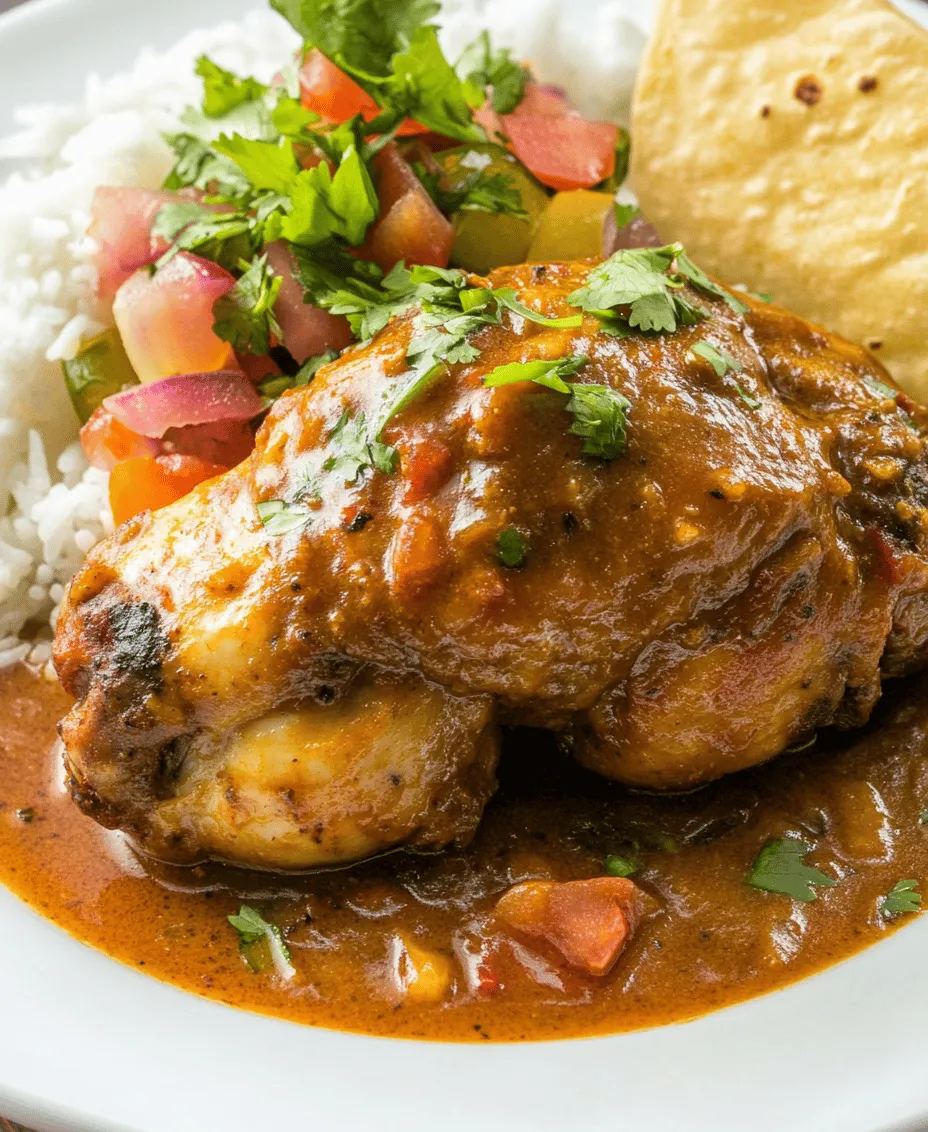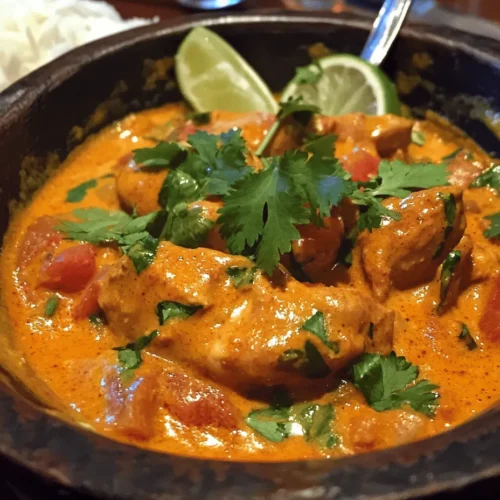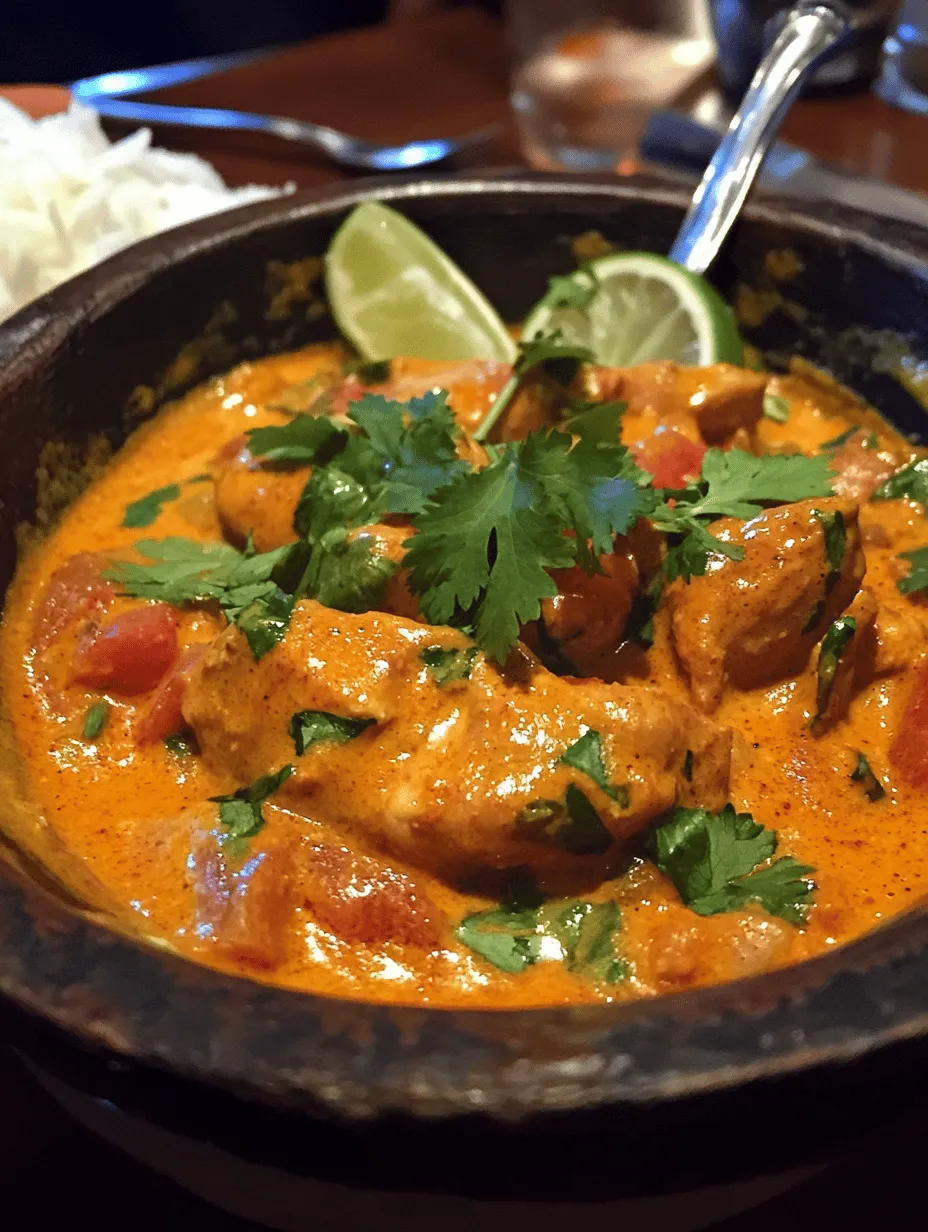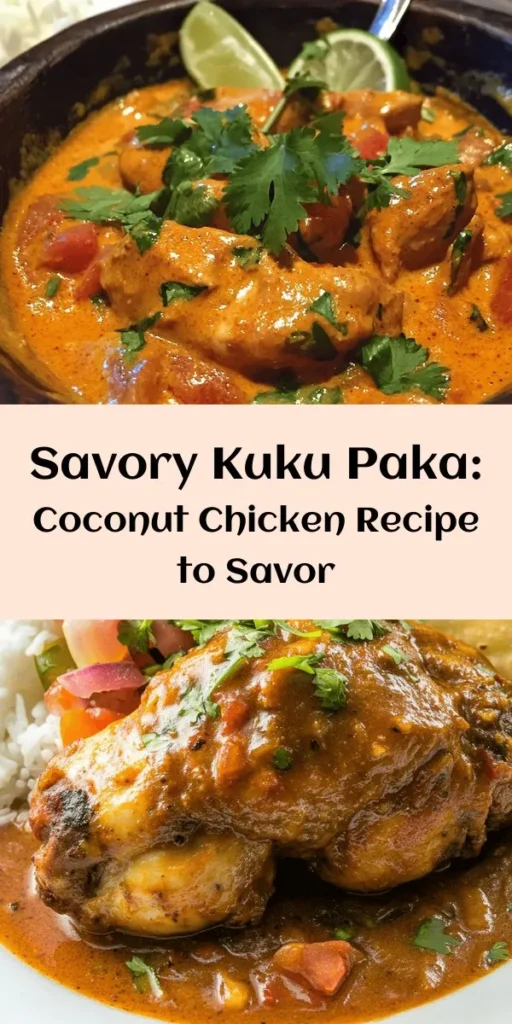Introduction to Kuku Paka: A Culinary Journey Through East Africa
Kuku Paka is not just a meal; it’s a culinary experience that transports you straight to the heart of East Africa. This traditional dish, which finds its roots primarily in Kenya and Tanzania, is a celebration of flavor and culture. The combination of spiced chicken simmered in rich coconut milk makes Kuku Paka a unique dish that stands out in the diverse landscape of East African cuisine.
As you embark on this culinary journey, you’ll discover how the harmonious blend of aromatic spices and creamy coconut milk can elevate simple chicken into a delightful feast. The dish reflects the rich heritage of the region, drawing influences from Indian and Arab cooking traditions, which have melded beautifully with local flavors over centuries. Kuku Paka is not just a meal; it is a symbol of hospitality and community, often served during family gatherings, celebrations, and communal feasts.
In this article, we will delve deep into the origins of Kuku Paka, its key ingredients, and provide you with a step-by-step guide on how to prepare this exquisite dish. By the end, you will have the knowledge and skills to create Kuku Paka in your kitchen, along with a newfound appreciation for its cultural significance.
Understanding the Origins of Kuku Paka
Historical Background of Kuku Paka
The origins of Kuku Paka can be traced back to the coastal regions of East Africa, where the interplay of cultures has given rise to a rich and diverse culinary landscape. The Swahili culture, which is predominant in coastal Kenya and Tanzania, has been significantly influenced by the spice trade, bringing together flavors and techniques from various parts of the world.
Indian and Arab culinary traditions have played a pivotal role in shaping the dish we know today as Kuku Paka. The use of spices like cumin, coriander, and garam masala speaks to the Indian influence, while the incorporation of coconut milk is reminiscent of the Arab culinary tradition, where coconut is a staple ingredient in many dishes. The combination of these elements creates a dish that is not only flavorful but also emblematic of the region’s rich history and cultural interactions.
In many households, Kuku Paka is a cherished recipe passed down through generations, often prepared during special occasions or family gatherings. Its unique flavor profile and comforting nature make it a beloved dish in East African cuisine.
Cultural Significance of Kuku Paka
Kuku Paka is more than just a dish; it is an integral part of East African culture and community life. In many households, the preparation of Kuku Paka is a communal affair, bringing family and friends together in the kitchen. The act of cooking and sharing this meal fosters a sense of belonging and unity, reinforcing the bonds between loved ones.
During celebrations and festive events, Kuku Paka often takes center stage on the dining table, showcasing the warmth and hospitality of East African culture. It is a dish that signifies abundance and generosity, inviting everyone to partake in the feast. Whether it’s a family gathering, a wedding, or a holiday celebration, Kuku Paka embodies the spirit of sharing and togetherness.
The dish’s popularity has also transcended borders, with variations appearing in different countries and regions. Each version tells its own story, reflecting local ingredients and traditions while retaining the essence of Kuku Paka. This adaptability and universal appeal make it a significant culinary treasure in East Africa and beyond.
Key Ingredients That Make Kuku Paka Shine
Chicken: The Star of the Dish
At the heart of Kuku Paka is the chicken, which serves as the primary protein and focal point of the dish. When preparing Kuku Paka, it is essential to use bone-in chicken pieces, as they impart a deeper flavor and richness to the sauce. Cuts such as thighs and drumsticks are particularly well-suited for this recipe, as they remain tender and juicy even after cooking.
The choice of chicken cut can significantly impact the overall experience of the dish. Bone-in cuts tend to retain moisture better, resulting in succulent pieces that soak up the aromatic spices and coconut milk beautifully. While boneless chicken may be a quicker option, it lacks the depth of flavor that bone-in chicken provides, making it less ideal for this traditional recipe.
The Spice Blend
The magic of Kuku Paka lies in its vibrant spice blend, which infuses the chicken with layers of flavor. The primary spices used in this dish include curry powder, ground cumin, ground coriander, and garam masala. Each spice brings its unique characteristics, creating a well-rounded and aromatic profile that elevates the dish.
– Curry Powder: This spice is a blend of various spices, including turmeric, coriander, and fenugreek, which contribute warmth and depth to the dish.
– Ground Cumin: Known for its earthy and slightly nutty flavor, cumin adds a robust aroma that complements the other spices.
– Ground Coriander: With its citrusy notes, coriander brightens the dish and adds a refreshing element to the flavor profile.
– Garam Masala: This spice blend, typically containing cardamom, cinnamon, and cloves, adds warmth and complexity to the dish, rounding out the overall taste.
Fresh ingredients like garlic, ginger, and green chilies also play a crucial role in enhancing the flavor of Kuku Paka. Garlic and ginger provide a fragrant base, while green chilies add a touch of heat, allowing you to adjust the spice level to your preference.
Coconut Milk: The Creamy Element
Coconut milk is the heart of Kuku Paka, providing a rich and creamy texture that balances the spices beautifully. The choice of coconut milk is essential; using full-fat coconut milk results in a luscious sauce that clings to the chicken, creating a decadent experience.
Beyond its flavor, coconut milk offers health benefits, including healthy fats that can provide energy and aid in nutrient absorption. Additionally, it helps mellow the spices, making the dish more approachable for those who may be sensitive to heat. The creaminess of coconut milk creates a delightful contrast to the bold spices, resulting in a harmonious balance that makes Kuku Paka an irresistible dish.
Fresh Garnishes
No dish is complete without the finishing touches, and Kuku Paka is no exception. Fresh garnishes such as cilantro and lime juice not only enhance the visual appeal of the dish but also elevate its flavor profile. Fresh cilantro adds a burst of freshness and color, while a squeeze of lime juice introduces a zesty brightness that cuts through the richness of the coconut milk.
Incorporating these garnishes just before serving is essential, as they add a final layer of flavor and freshness. The vibrant colors and aromas of the garnishes make Kuku Paka not only a delight to the palate but also a feast for the eyes.
—
Step-by-Step Preparation of Kuku Paka
Now that you have a deeper understanding of the origins and key ingredients of Kuku Paka, let’s dive into the preparation process. The first step in creating this mouthwatering dish is marinating the chicken, which is crucial for flavor absorption.
Marinating the Chicken
Marination is a vital step in the Kuku Paka preparation process, allowing the chicken to absorb all the wonderful spices and flavors. For optimal results, it is recommended to marinate the chicken for at least 1 hour, though overnight marination in the refrigerator yields even better results.
To prepare the marinade, combine the following ingredients in a bowl:
– Spices: Add a teaspoon of curry powder, ground cumin, ground coriander, and garam masala to the bowl.
– Fresh Ingredients: Include minced garlic, grated ginger, and finely chopped green chilies for an aromatic kick.
– Acid: Squeeze in the juice of half a lime, which not only adds flavor but also helps tenderize the chicken.
– Salt: Season with salt to taste.
Once the marinade is ready, coat the chicken pieces thoroughly, ensuring that they are well-covered. This allows the spices to penetrate the meat, resulting in a flavorful and aromatic dish. Cover the bowl with plastic wrap or transfer the chicken to a resealable bag, and place it in the refrigerator to marinate.
As the chicken marinates, it will absorb the spices’ essence, enhancing its flavor and tenderness. This step is crucial, as it lays the foundation for the delicious Kuku Paka you will create.
In the next section, we will explore the cooking process that brings all these elements together, resulting in a dish that is sure to impress your family and friends. Stay tuned as we unravel the secrets to perfecting Kuku Paka!

Preparing the Flavor Base
The flavor base of Kuku Paka is essential for creating that deep, rich taste that defines the dish. Start by finely chopping two medium-sized onions. The technique for sautéing these onions is crucial; you want them to turn a beautiful golden brown without burning. To achieve this, heat a generous amount of oil (about 2-3 tablespoons) in a large pan over medium heat. Once the oil is shimmering, add the onions and stir them gently, ensuring they are evenly coated.
Cook the onions for about 10-15 minutes, stirring occasionally. The goal is to develop their natural sweetness, which will serve as the backbone of your flavor profile. As the onions begin to caramelize, you will notice a rich aroma filling your kitchen. This is your cue to add spices. First, sprinkle in a teaspoon of salt to help release the moisture from the onions and enhance their flavor.
Next, introduce the spices: a tablespoon of minced garlic, a tablespoon of grated ginger, and your choice of spices such as cumin, coriander, and turmeric. These spices not only add depth but also create a warm, inviting fragrance. Stir these ingredients together, allowing them to cook for an additional 2-3 minutes until fragrant, which will maximize the aroma that permeates your kitchen.
Cooking the Chicken
Once your flavor base is ready, it’s time to add the chicken. For this recipe, you’ll want to use about 1.5 to 2 pounds of chicken, cut into pieces. Before adding the chicken to the pan, ensure it is pat-dried with a paper towel. This step is vital for achieving a nice brown crust. Increase the heat to medium-high and add the chicken pieces skin-side down, if applicable. Avoid overcrowding the pan; you may need to do this in batches.
Allow the chicken to sear for about 5-7 minutes on each side until it’s golden brown. This browning process not only enhances the flavor but also locks in the juices, keeping the chicken tender during cooking. After the chicken has browned, remove it from the pan and set it aside.
Next, add diced tomatoes (around 2 medium-sized) to the pan, scraping up any browned bits from the bottom. This deglazing process adds another layer of flavor to your dish. The tomatoes will cook down and contribute acidity to balance the richness of the coconut milk that is to follow. Allow the tomatoes to simmer for about 5 minutes until they break down and meld with the spices and onions.
Incorporating Coconut Milk
Now it’s time to introduce the star ingredient: coconut milk. Pour in one can (about 13.5 ounces) of full-fat coconut milk, stirring it into the tomato and onion mixture. It’s essential to combine the coconut milk thoroughly to create a smooth sauce. The creaminess of the coconut milk will envelop the chicken, infusing it with flavor.
Return the browned chicken pieces to the pan, making sure they are submerged in the coconut milk sauce. Bring the mixture to a gentle simmer, cover the pan, and lower the heat to medium-low. This step is crucial for ensuring that the chicken cooks evenly and remains tender. Cook for about 25-30 minutes, checking occasionally to stir and ensure that the sauce does not stick to the bottom of the pan.
Final Touches
As your Kuku Paka simmers, it’s time to finalize the dish. After 30 minutes, check the chicken for doneness— it should be cooked through and tender, with juices running clear. Adjust the seasoning at this stage by tasting the sauce. You may want to add a pinch more salt, a dash of pepper, or even a squeeze of lime juice for brightness. This is your opportunity to personalize the flavor to your liking.
To enhance the presentation, consider garnishing with freshly chopped cilantro or parsley. This not only adds a pop of color but also freshens the dish. Serve the Kuku Paka hot, drizzling some of the rich coconut sauce over the chicken and garnishing before serving.
Serving Suggestions for Kuku Paka
Accompaniments
Kuku Paka shines when served with traditional accompaniments. Steamed rice is a classic pairing, as it absorbs the delicious coconut sauce beautifully. Alternatively, you can serve it with chapati, which adds a delightful texture and flavor. For a heartier meal, consider pairing Kuku Paka with a side of fried plantains or a simple green salad to balance the richness of the dish.
If you’re looking to create a complete East African culinary experience, consider adding a side of sukuma wiki, a sautéed kale dish, which provides a nutritious and vibrant addition to your plate.
Presentation Ideas
To elevate your dining experience, presentation plays a key role. Serve Kuku Paka in a large, shallow bowl, allowing the sauce to pool at the bottom and showcasing the vibrant colors of the chicken and garnishes. You can also serve individual portions on decorative plates, accompanied by a small bowl of extra coconut sauce for dipping.
For gatherings, consider a communal serving style, placing the Kuku Paka in the center of the table alongside steaming bowls of rice and chapati. Encourage guests to serve themselves, creating a warm and inviting atmosphere. Don’t forget to add a few sprigs of cilantro or lime wedges on the side for a fresh touch that invites guests to enhance their plates.
Nutritional Value of Kuku Paka
Breakdown of Key Nutrients
Kuku Paka is not only delicious but also packed with nutritional benefits. Chicken is a great source of lean protein, essential for muscle repair and overall health. It is low in fat, especially if you opt for skinless pieces, making it a heart-healthy option. Additionally, coconut milk provides healthy fats, particularly medium-chain triglycerides (MCTs), which may aid in energy production and metabolic health.
The spices used in Kuku Paka, such as turmeric and ginger, offer anti-inflammatory properties and a myriad of health benefits. Turmeric is known for its curcumin content, which has been studied for its potential to reduce inflammation and support joint health. Ginger, on the other hand, aids digestion and can help alleviate nausea.
Balancing Kuku Paka in a Meal Plan
When incorporating Kuku Paka into a balanced diet, portion control is essential. A serving size of Kuku Paka alongside a cup of steamed rice or chapati offers a well-rounded meal. To maintain a balanced approach, consider the overall composition of your plate. Aim to fill half your plate with vegetables, a quarter with carbohydrates, and a quarter with protein from the chicken.
Mindful eating strategies can enhance the enjoyment of your meal. Take the time to savor each bite, appreciating the complexity of flavors and the effort that went into preparing this dish. This approach not only contributes to a satisfying dining experience but also aids in digestion and overall well-being.
Conclusion: Savoring the Flavors of Kuku Paka
Kuku Paka is more than just a meal; it is a celebration of East African culture, community, and culinary artistry. With its harmonious blend of spices, tender chicken, and creamy coconut milk, this dish offers a unique gastronomic experience. Whether you are sharing it with family or introducing friends to the flavors of East Africa, Kuku Paka stands out as a delightful centerpiece on any table.
As you embark on your culinary journey to recreate this dish, remember that each bite is steeped in tradition and love. Enjoy the process and the delicious results that follow. Embrace the warmth and richness of Kuku Paka, and let it transport you to the vibrant streets of East Africa.



